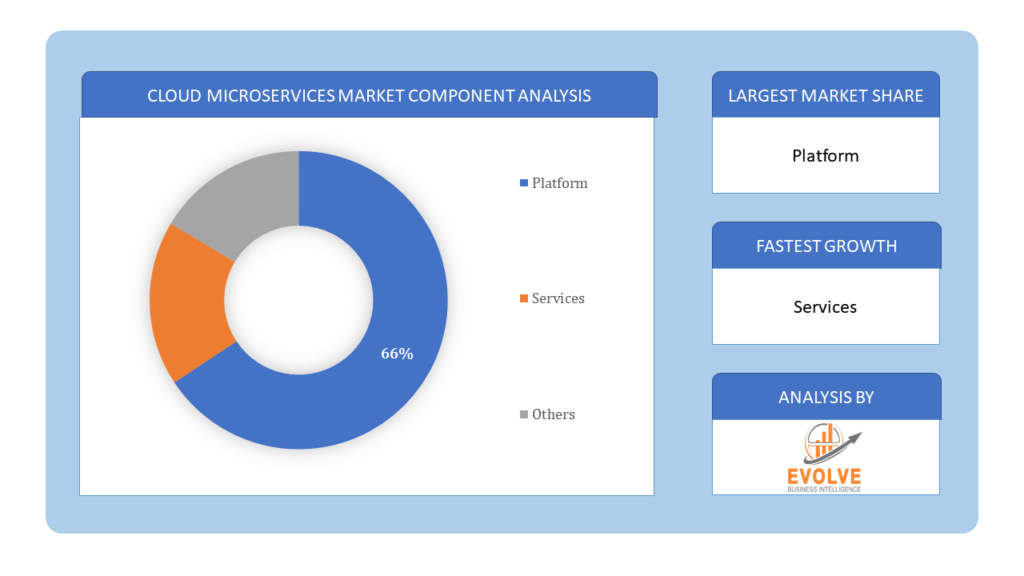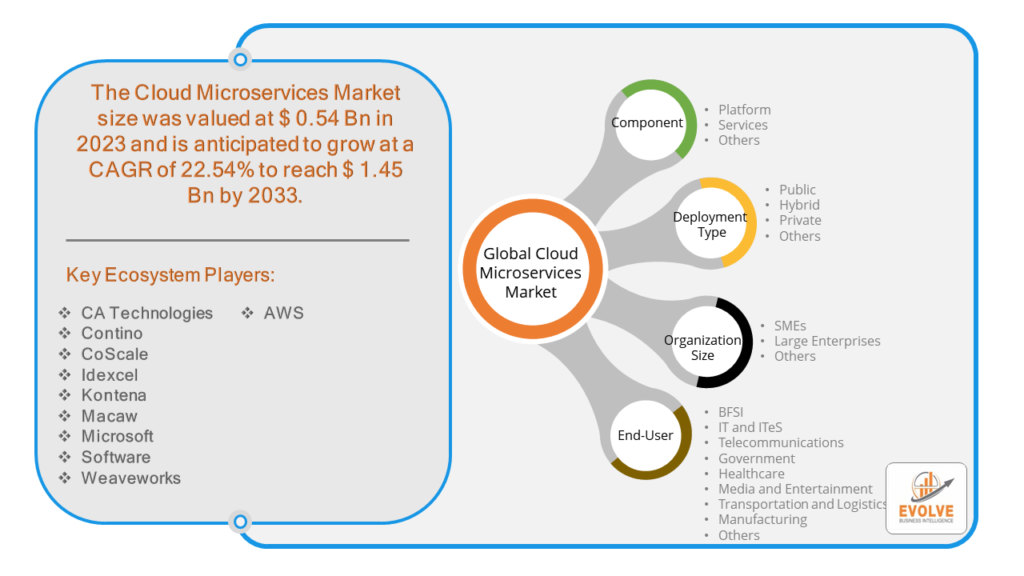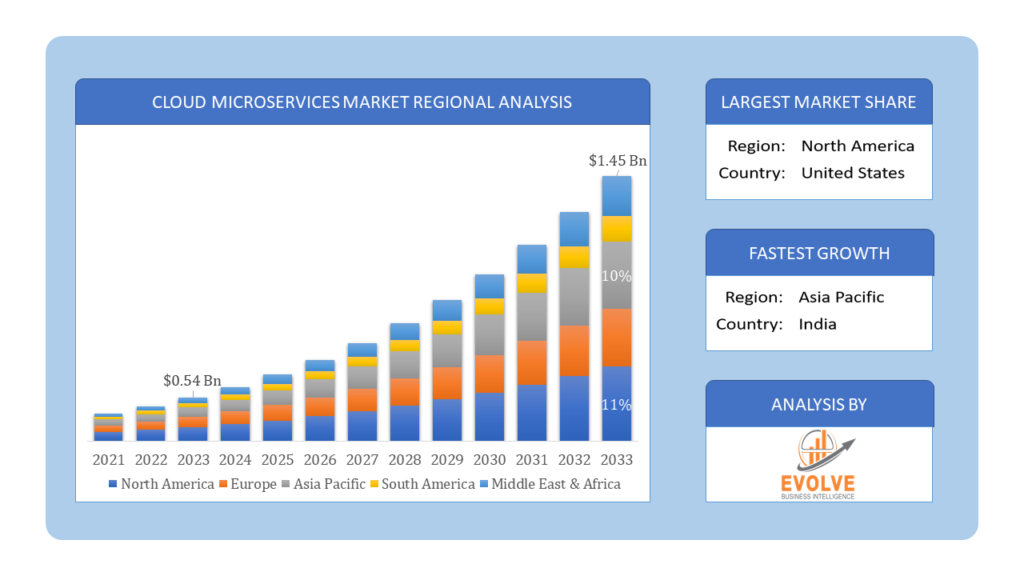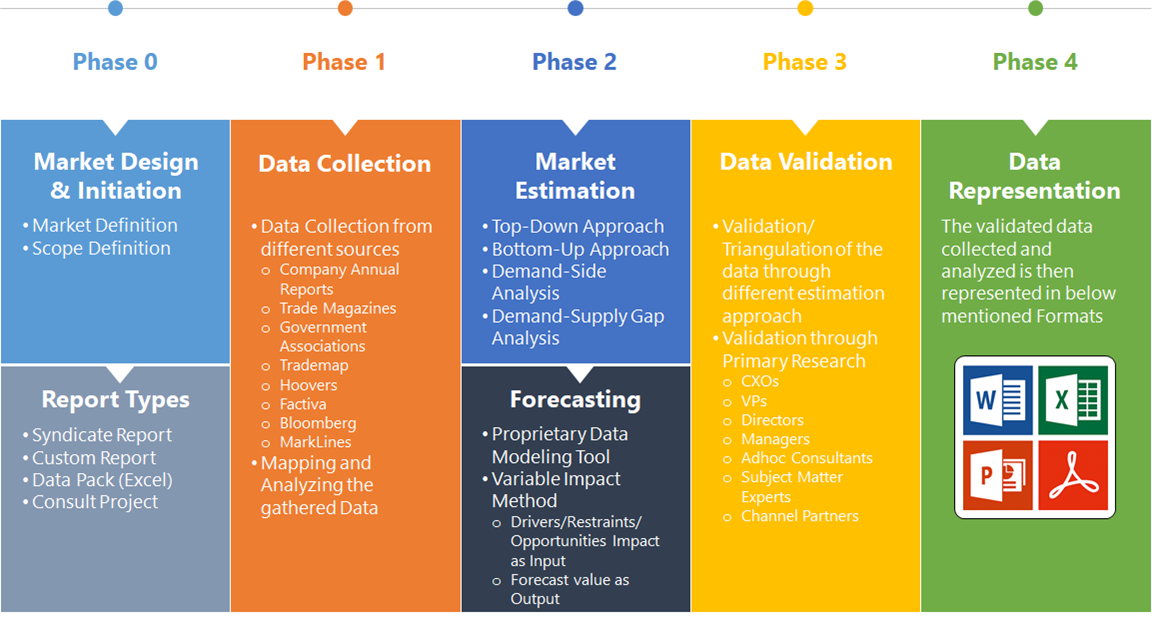Cloud Microservices Market Overview
The Cloud Microservices Market Size is expected to reach USD 1.45 Billion by 2033. The Cloud Microservices Market industry size accounted for USD 0.54 Billion in 2023 and is expected to expand at a compound annual growth rate (CAGR) of 22.54% from 2023 to 2033. The Cloud Microservices Market refers to the segment of the IT industry that involves the development, deployment, and management of microservices-based Applications in cloud computing environments. Microservices architecture is an approach to software development where Applications are built as a collection of loosely coupled, independently deployable services. These services are organized around specific business capabilities and communicate with each other via well-defined APIs.
The adoption of microservices architecture in cloud environments has been driven by the need for agility, scalability, and flexibility in software development, allowing organizations to rapidly develop and deploy Applications while leveraging the scalability and resources of cloud platforms. The Cloud Microservices Market continues to grow as more organizations embrace microservices architecture and migrate their Applications to cloud environments to take advantage of the benefits it offers.
Global Cloud Microservices Market Synopsis
The COVID-19 pandemic had a significant impact on the Cloud Microservices Market. The pandemic accelerated the digital transformation efforts of many organizations as they sought to enable remote work, support online collaboration, and ensure business continuity. This surge in demand for cloud services, including microservices-based solutions, has driven growth in the Cloud Microservices Market. Microservices architecture offers scalability and flexibility, which became crucial during the pandemic. Organizations needed to quickly adapt to changing market conditions, scale their Applications to meet increased demand, and integrate new functionalities into existing systems. Cloud-based microservices provided the agility needed to respond to these challenges. Many businesses faced financial constraints during the pandemic and looked for ways to optimize their IT spending. Cloud-based microservices offer cost advantages such as pay-as-you-go pricing models and the ability to scale resources based on demand, helping organizations reduce infrastructure costs while maintaining performance and agility.
Cloud Microservices Market Dynamics
The major factors that have impacted the growth of Cloud Microservices Market are as follows:
Drivers:
Ø Digital Transformation
Organizations across industries are undergoing digital transformation initiatives to stay competitive, improve operational efficiency, and deliver better customer experiences. Cloud microservices offer a modular and scalable architecture that supports agile development and enables organizations to modernize their legacy systems while embracing new technologies. Cloud microservices often follow a pay-as-you-go pricing model, allowing organizations to reduce upfront infrastructure costs and scale resources based on demand. This cost efficiency is particularly attractive for startups and small-to-medium businesses looking to innovate without large capital investments. Cloud microservices facilitate the adoption of hybrid and multi-cloud strategies, allowing organizations to deploy Applications across multiple cloud providers or integrate with on-premises infrastructure. This flexibility enables organizations to leverage the best-in-class services from different cloud vendors while avoiding vendor lock-in.
Restraint:
- Perception of Complexity and Learning Curve
Adopting microservices architecture requires a shift in mindset and often involves a steep learning curve for development teams. Microservices introduce complexity in areas such as service discovery, inter-service communication, and distributed data management, which can challenge organizations, especially those with limited experience in cloud-native development. While cloud microservices offer cost efficiency through pay-as-you-go pricing models, the granular nature of microservices can lead to increased infrastructure costs, especially if not properly managed. Organizations may need to invest in infrastructure optimization tools and strategies to minimize unnecessary resources consumption and control costs effectively.
Opportunity:
⮚ Cost Efficiency and Resource Optimization
Microservices architecture offers cost efficiency through its pay-as-you-go model, allowing organizations to optimize resource utilization and reduce infrastructure costs. By scaling resources based on demand and leveraging cloud-native services, businesses can achieve cost savings while maintaining performance and reliability. Microservices architecture facilitates digital transformation initiatives by enabling organizations to modernize their legacy systems, embrace new technologies, and adopt agile development practices. Cloud-native microservices allow businesses to break down monolithic Applications into smaller, more manageable components, making it easier to iterate, innovate, and scale. Cloud microservices support hybrid and multi-cloud strategies, allowing organizations to deploy Applications across multiple cloud providers or integrate with on-premises infrastructure. This flexibility enables businesses to leverage the best-in-class services from different cloud vendors, avoid vendor lock-in, and ensure high availability and resilience.
Cloud Microservices Market Segment Overview
By Components
 Based on Components, the market is segmented based on Platform, Services and Others. The platform segment dominated the market. The Platform segment is anticipated to have a bigger market size during the projected period due to the growing demand for cloud microservices architecture in every business vertical for scaling functions at a very granular level, leading to effective system optimization and organization.
Based on Components, the market is segmented based on Platform, Services and Others. The platform segment dominated the market. The Platform segment is anticipated to have a bigger market size during the projected period due to the growing demand for cloud microservices architecture in every business vertical for scaling functions at a very granular level, leading to effective system optimization and organization.
By Deployment Type
Based on Deployment Type, the market segment has been divided into Public, Hybrid, Private and Others. Hybrid held the largest segment. Due to its advantages over the other two deployment groups in terms of flexibility, scalability, and cost-effectiveness, the hybrid cloud has the highest market demand. It is a better choice to compare a hybrid cloud to other cloud-based or non-cloud-based alternatives. Scalability, security, affordability, control, and speed are advantages.
By Organization Size
Based on Organization Size, the market segment has been divided into SMEs, Large Enterprises and Others. The large enterprise category generated the most income. Big businesses dominate the industry due to their dedication to streamlining the administration and maintenance of cloud-native apps. The segment’s expansion is primarily attributable to major organizations’ need for higher-quality goods and an efficient development process. More spending on R&D also contributes to higher company productivity.
By End User
Based on End User, the market segment has been divided into BFSI, IT and ITeS, Telecommunications, Government, Healthcare, Media and Entertainment, Transportation and Logistics, Manufacturing and Others.
Global Cloud Microservices Market Regional Analysis
Based on region, the global Cloud Microservices Market has been divided into North America, Europe, Asia-Pacific, the Middle East & Africa, and Latin America. North America is projected to dominate the use of the Cloud Microservices Market followed by the Asia-Pacific and Europe regions.
 Cloud Microservices North America Market
Cloud Microservices North America Market
North America holds a dominant position in the Cloud Microservices Market. North America is a leading region in the Cloud Microservices Market, driven by the presence of major technology hubs such as Silicon Valley and Seattle. The region benefits from robust technological infrastructure, a strong culture of innovation and entrepreneurship, and a large base of cloud-native startups and established enterprises. The United States, in particular, accounts for a significant portion of the market, with cloud service providers, technology vendors, and enterprises adopting microservices architecture to drive digital transformation initiatives.
Cloud Microservices Asia-Pacific Market
The Asia-Pacific region has indeed emerged as the fastest-growing market for the Cloud Microservices Market industry. The Asia Pacific region represents a significant growth opportunity for the Cloud Microservices Market, fueled by rapid economic development, urbanization, and increasing digitalization across sectors. Countries such as China, India, Japan, and Australia are witnessing a surge in cloud adoption, driven by the proliferation of mobile devices, rising internet penetration, and the emergence of digital-native startups. Asian enterprises are leveraging cloud microservices to scale their operations, launch new services, and reach a growing consumer base in the region.
Competitive Landscape
The global Cloud Microservices Market is highly competitive, with numerous players offering a wide range of software solutions. The competitive landscape is characterized by the presence of established companies, as well as emerging startups and niche players. To increase their market position and attract a wide consumer base, the businesses are employing various strategies, such as product launches, and strategic alliances.
Prominent Players:
- CA Technologies
- Contino
- CoScale
- Idexcel
- Kontena
- Macaw
- Microsoft
- Software
- Weaveworks
- AWS
Key Development
In January 2022, A top supplier of EHS software and content, Red-on-line, has acquired Gutwinski Management GmbH, a top provider of EHS platform solutions. The purchase will produce a client portfolio product that is fundamentally complimentary and present a chance to expand the number of clients who can access goods and services globally.
Scope of the Report
Global Cloud Microservices Market, by Components
- Platform
- Services
- Others
Global Cloud Microservices Market, by Deployment Type
- Public
- Hybrid
- Private
- Others
Global Cloud Microservices Market, by Organization Size
- SMEs
- Large Enterprises
- Others
Global Cloud Microservices Market, by End User
- BFSI
- IT and ITeS
- Telecommunications
- Government
- Healthcare
- Media and Entertainment
- Transportation and Logistics
- Manufacturing
- Others
Global Cloud Microservices Market, by Region
- North America
- US
- Canada
- Mexico
- Europe
- UK
- Germany
- France
- Italy
- Spain
- Benelux
- Nordic
- Rest of Europe
- Asia Pacific
- China
- Japan
- South Korea
- Indonesia
- Austalia
- Malaysia
- India
- Rest of Asia Pacific
- South America
- Brazil
- Argentina
- Rest of SouthAmerica
- Middle East &Africa
- Saudi Arabia
- UAE
- Egypt
- SouthAfrica
- Rest of Middle East & Africa
| Parameters | Indicators |
|---|---|
| Market Size | 2033: $1.45 Billion |
| CAGR | 22.54% CAGR (2023-2033) |
| Base year | 2022 |
| Forecast Period | 2023-2033 |
| Historical Data | 2021 |
| Report Coverage | Revenue Forecast, Competitive Landscape, Growth Factors, and Trends |
| Key Segmentations | Components, Deployment Type, Organization Size, End User |
| Geographies Covered | North America, Europe, Asia-Pacific, Latin America, Middle East, Africa |
| Key Vendors | CA Technologies, Contino, CoScale, Idexcel, Kontena, Macaw, Microsoft, Software, Weaveworks and AWS |
| Key Market Opportunities | • Cost Efficiency and Resource Optimization • Support for Digital Transformation |
| Key Market Drivers | • Digital Transformation • Support for Hybrid and Multi-Cloud Environments |
REPORT CONTENT BRIEF:
- High-level analysis of the current and future Cloud Microservices Market trends and opportunities
- Detailed analysis of current market drivers, restraining factors, and opportunities in the future
- Cloud Microservices Market historical market size for the year 2021, and forecast from 2023 to 2033
- Cloud Microservices Market share analysis at each product level
- Competitor analysis with detailed insight into its product segment, Government & Defense strength, and strategies adopted.
- Identifies key strategies adopted including product launches and developments, mergers and acquisitions, joint ventures, collaborations, and partnerships as well as funding taken and investment done, among others.
- To identify and understand the various factors involved in the global Cloud Microservices Market affected by the pandemic
- To provide a detailed insight into the major companies operating in the market. The profiling will include the Government & Defense health of the company’s past 2-3 years with segmental and regional revenue breakup, product offering, recent developments, SWOT analysis, and key strategies.







